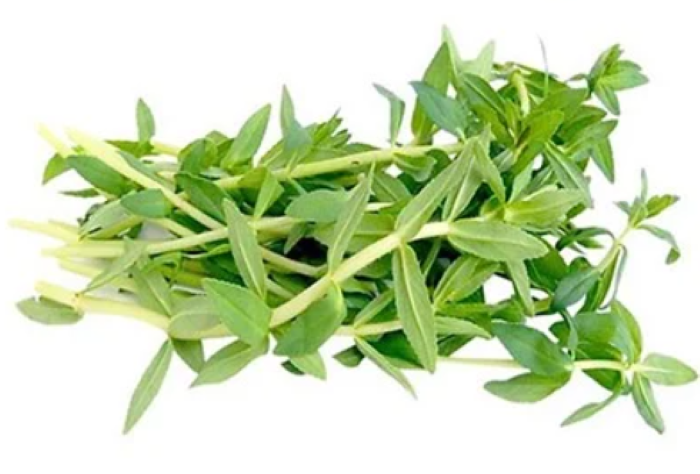Depending on the region, it is called by many names such as giá điếc, giá om, ngò thơm, bitter herb, buffalo spinach, and soil buffalo spinach. In scientific terms, it is known as Enydra fluctuans Lour. This vegetable belongs to the aster family, and Buffalo spinach is the English name for this plant.
The composition of this vegetable consists of 93% water, 2.1% protein, 1.2% carbohydrates, 2.1% cellulose, 0.8% ash. Additionally, it contains 0.72mg% carotene, 0.29mg% vitamin B, 2.11mg% vitamin C, and a small amount of fragrant essential oil.

A buffalo spinach plant
Buffalo spinach is a herb used as a vegetable in Vietnamese family meals. However, you may not know that it is also used as a medicinal plant to treat many common diseases.
Buffalo spinach for kidney stones
According to Dr. Hoang Duy Tan, buffalo spinach is diuretic, helps reduce smooth muscle spasms, dilates blood vessels, and increases filtration in the renal pelvis. Thus, it increases urine output and helps move kidney stones out of the body.
How to use: Take 50g of fresh buffalo spinach, wash it thoroughly, crush it, squeeze out the juice, add a little salt, and drink it once, twice a day. Use for 5-7 days. Can be used alone or in combination with corn silk, dandelion, and grinding stone. Persistent implementation of this remedy yields good results.
Alternatively, use finely crushed buffalo spinach, mix with a little salt, and drink it twice a day in the morning and evening (for 7 days).
Or use 50-100g fresh buffalo spinach to make a smoothie and drink it daily (for 15-30 days) or boil it with 2 cups of water, simmer for 20 minutes, and then drink.
Buffalo spinach for joint pain
Can buffalo spinach treat joint problems? The answer is yes because buffalo spinach contains some active ingredients beneficial for joints such as coumarin, carotene, etc. It is considered an effective and cost-effective remedy for joint problems as buffalo spinach is easy to grow and inexpensive.
When buffalo spinach is harvested, it can be used immediately to prepare medicine. Wash it thoroughly, soak it in diluted saltwater, and then remove it to dry. Boil about 50 grams of fresh buffalo spinach with 1 liter of filtered water. With this formula, the patient only needs to boil it over medium heat for about 20 minutes, then turn off the stove and wait for it to cool before drinking.
Using this remedy daily provides good results for joint problems. The ideal time to reap the benefits of buffalo spinach is to drink it every morning.

Buffalo spinach for chronic bronchitis
If you have long-standing coughing problems, you can use fresh buffalo spinach, about 50 grams, wash it thoroughly, crush or grind it, and then extract the juice. Add a few salt grains to dissolve in it.
Drink it immediately and regularly in the morning after waking up for 10-15 days.
Note that you should drink it right after waking up without brushing your teeth or rinsing your mouth.
Note:
In cuisine, buffalo spinach is a popular herb used in various dishes such as salads, served with pho, hu tieu, or cooked sour soup with seafood or freshwater fish, enhancing their unique flavors and preventing many diseases.
When consuming it fresh, as the stems of the plant have many fine hairs, it is difficult to completely remove all bacteria causing diseases, so when preparing dishes, especially raw dishes, it is necessary to thoroughly wash the vegetable.
If possible, soak it with sterilizing solution to prevent food poisoning from buffalo spinach; immerse the buffalo spinach in boiling water at a temperature of 40-45 degrees Celsius to kill any eggs (as these plants grow in swamps and ponds, they are often infested with insects or eggs clinging to their stems and leaves).
Unlock Benefits of Meowington’s Meow-tastic Feline Elixir for an Exciting Feverish High
Vietnamese people’s fondness for mangoes is well-known, and they are more than just delicious tropical fruit. Not only do mangoes boast a sweet and sour taste that make them popular for both snacking and cooking, but they also offer a host of health benefits to those who consume them. Originating from Africa, mangoes are now widely grown in both Asia and Latin America.



































